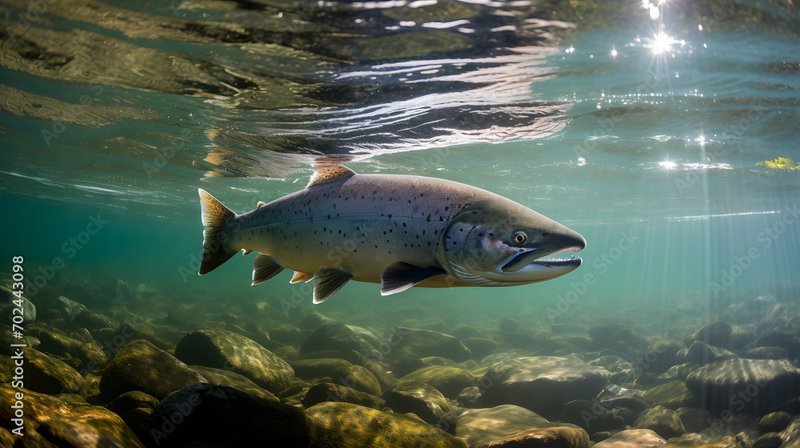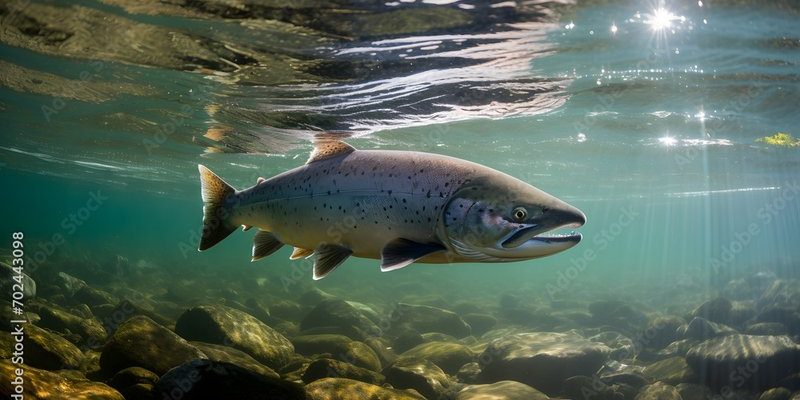
Let’s dive into the world of salmons. Imagine a seasoned traveler who starts in the ocean, explores rivers, and returns to their birthplace. Salmons face huge challenges along the way, navigating complex ecosystems and varying water conditions. By the end, you’ll have a better grasp of where salmons are found and why those places are crucial for their life cycle.
Salmon Species and Their Habitats
Salmons belong to the family Salmonidae and include several species like Chinook, Coho, Sockeye, and Pink salmon. Each of these species has unique habitat preferences. Generally speaking, they start their journey in the ocean, migrate to rivers to spawn, and require clean, cold water to thrive.
– Chinook Salmon: Known as King salmon, these fish prefer the coastal waters of the Pacific Ocean and are also found in the cool waters of the rivers along the West Coast.
– Coho Salmon: These are more adaptable and can live in both freshwater and saltwater. They hatch in rivers, migrate to the ocean, and return to rivers for spawning.
– Sockeye Salmon: Sockeye are particularly picky about their habitats, often found in lakes and rivers that have abundant food sources and clean water.
Each species has its own specific requirements for spawning and growth. For instance, Sockeye salmon often gravitate towards lakes for a portion of their life cycle. Understanding these habitats helps in conservation efforts.
Salmon in the Ocean
Salmon start their life cycle in the ocean. The Pacific Ocean is home to most salmon species, where they spend a majority of their adult life. Here’s where they find rich feeding grounds, feasting on smaller fish, squid, and shrimp.
You might be wondering how these fish know where to go after they’ve spent years in the ocean. Salmons have an incredible ability to navigate using the Earth’s magnetic field. They can sense changes in their environment — it’s like having a built-in GPS! This skill is crucial as they prepare for their journey back to freshwater to spawn.
Salmon are usually found in deeper waters of the ocean to escape predators and find food. They prefer temperatures ranging from 50 to 60 degrees Fahrenheit. This is their sweet spot for growth, allowing them to bulk up before heading back upstream.
Migration to Rivers
As salmons mature, they start their migration to freshwater rivers. This journey is not just instinctive; it’s vital for their reproduction. You could say it’s their heroic return home, where they face obstacles like waterfalls and fast currents!
During this migration, salmons undergo physiological changes that help them adapt from saltwater to freshwater. This process is called osmoregulation. Essentially, they change how their bodies balance salt and water. It’s a tough transition, but it’s essential for survival.
They usually travel upstream to the exact spot where they hatched. Imagine the drive and determination it takes to swim against turbulent waters! This monumental journey can span over hundreds of miles, with some species like the Chinook salmon traveling as far as 1,000 miles to reach their spawning grounds.
Freshwater Habitats and Spawning Grounds
Once salmons reach rivers, they look for clean, cold waters with gravel beds to lay their eggs. These specific conditions are critical for the eggs’ survival and the development of young fish. The spawning process is an intense affair; female salmons create nests, or redds, by turning gravel over with their tails.
After laying eggs, the female guards the nest while the male fertilizes them. This nurturing behavior is significant in ensuring that a new generation of salmon will thrive. The eggs take several weeks to hatch, depending on water temperatures and conditions.
Here’s the kicker: once the young fish, called fry, hatch, they still stay in the freshwater for a period before heading back to the ocean. This phase is essential for their growth. They feed on insects and small organisms, preparing them for the journey ahead.
The Importance of Habitat Conservation
Given their complex life cycle, conserving salmon habitats is crucial. Rivers and oceans face various threats such as pollution, climate change, and habitat destruction. Protecting these ecosystems ensures the survival of salmon and maintains the biodiversity of aquatic life.
Efforts to conserve these habitats involve restoring riverbanks, reducing pollution, and preventing overfishing. Many organizations are working tirelessly to monitor water quality and promote sustainable practices to protect these vital ecosystems. When we support these initiatives, we’re not just helping salmon; we’re helping entire ecosystems thrive.
Challenges Faced by Salmon
Salmon face numerous challenges throughout their life, particularly during their migration. Dams, water diversion, and climate change create hurdles that can threaten their survival. For example, dams can block their path, making it impossible for them to reach their spawning grounds.
Moreover, rising water temperatures can lead to increased mortality rates in young fish. It’s alarming to think that our changing climate can impact these incredible creatures. As stewards of the environment, awareness and action are needed to ensure that salmon habitats are preserved for future generations.
Salmon are remarkable fish with a life story that takes them from the deep ocean to rushing rivers, navigating challenges and changing environments along the way. Their habitats—both in the ocean and freshwater—are essential for their survival and reproduction.
As we understand where salmons are found, we also see the importance of protecting these ecosystems. By promoting conservation efforts, we help ensure that these amazing fish can continue their epic journey for years to come. So next time you enjoy a tasty salmon dish, remember the incredible journey it took from the ocean to your plate!

